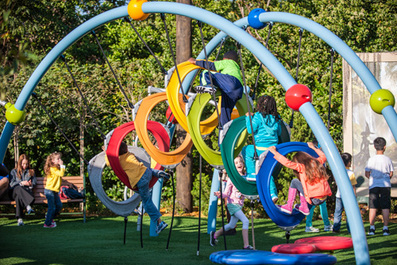
I often encourage parents and teachers that work with children with gross motor challenges to provide a “Just Right Challenge”. What exactly does that mean? It is asking the child to perform an activity that is just slightly harder than what they can already do.
A child learns new skills or improves on skills they already have, by trying something harder. If they keep doing an already mastered activity over and over, they will not progress their skills. If they attempt an activity that is way beyond what they are physically capable of, they may become frustrated, decide it is “too hard” and stop attempting the new task.
What does this look like for you, the adult? You need to be a bit of a detective. You need to observe the child to see “what can they do”? Then you need to decide “what is the next small step that they have the ability to learn or accomplish?” This could mean you decrease the amount of physical support that you offer them: holding one hand on a balance beam instead of two; or holding their trunk while they go up a playground climber but no longer helping them place their feet on the next rung. The difficult part is knowing how much can I let go without compromising their safety.
The next step could also be to help progress a skill. If your child holds their hands close together, palms up and close to chest in preparation to catch, could you show them how to hold their hands further apart and slightly away from their chest? You may need to soften your throw to assist in their success.
Your child may benefit from learning small pieces or steps of an activity before attempting to put all the pieces together. Once the child can do all or most of the steps, they will have an easier time sequencing all the steps together. It is normal for a child to easily perform some steps but need more help with others in the same activity.
Your job is to help when they need it and let them be independent with what they have mastered. This will lead to success and a feeling of accomplishment, rather than frustration and failure. Now go out and play!
A child learns new skills or improves on skills they already have, by trying something harder. If they keep doing an already mastered activity over and over, they will not progress their skills. If they attempt an activity that is way beyond what they are physically capable of, they may become frustrated, decide it is “too hard” and stop attempting the new task.
What does this look like for you, the adult? You need to be a bit of a detective. You need to observe the child to see “what can they do”? Then you need to decide “what is the next small step that they have the ability to learn or accomplish?” This could mean you decrease the amount of physical support that you offer them: holding one hand on a balance beam instead of two; or holding their trunk while they go up a playground climber but no longer helping them place their feet on the next rung. The difficult part is knowing how much can I let go without compromising their safety.
The next step could also be to help progress a skill. If your child holds their hands close together, palms up and close to chest in preparation to catch, could you show them how to hold their hands further apart and slightly away from their chest? You may need to soften your throw to assist in their success.
Your child may benefit from learning small pieces or steps of an activity before attempting to put all the pieces together. Once the child can do all or most of the steps, they will have an easier time sequencing all the steps together. It is normal for a child to easily perform some steps but need more help with others in the same activity.
Your job is to help when they need it and let them be independent with what they have mastered. This will lead to success and a feeling of accomplishment, rather than frustration and failure. Now go out and play!

 RSS Feed
RSS Feed